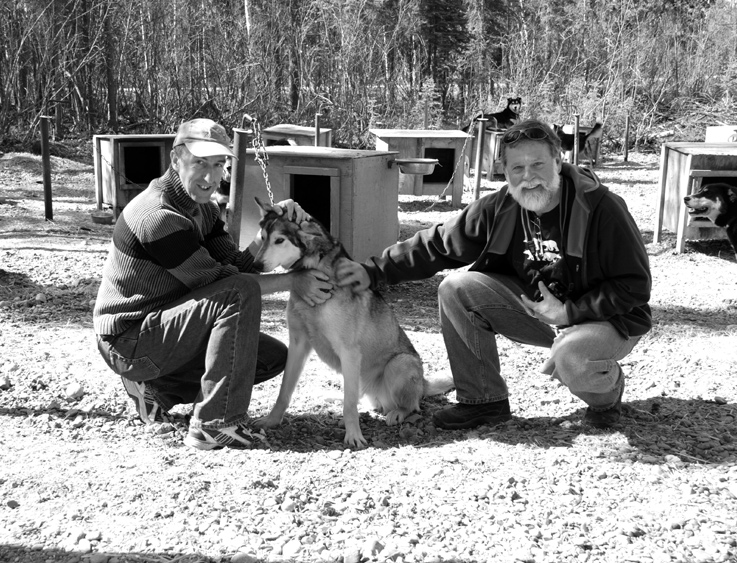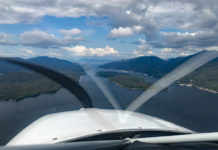Some places just enchant you. No matter how many times you go there it isn’t enough. Alaska is like that for me. It was thus not too much of a chore for me to organize a trip to my favorite place for myself and a few of our members. Four planes finally made the trip with many more who had hoped to go, but couldn’t for any number of reasons. This ended up being about enough — not too many and not too few. We could have handled one of two more, or I suppose one or two less, but four worked out well.
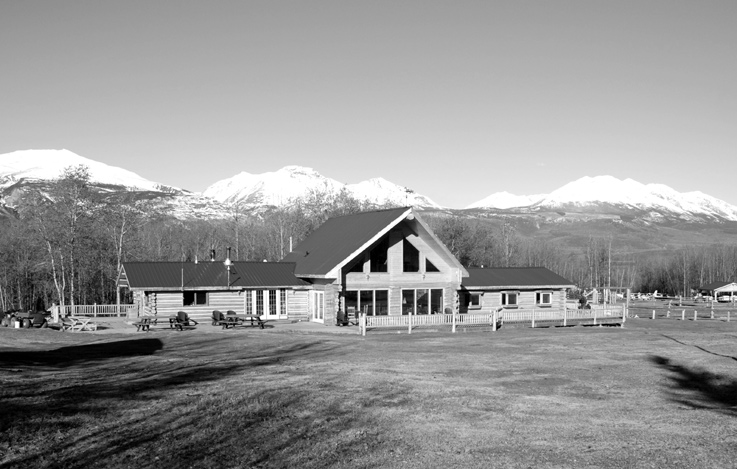
Peter Cattoni of British Columbia, Canada, flew his GlaStar trike with Werner Schneider of Switzerland. Since they had a bit of a head start on the rest of us we met up with them in Williams Lake, BC. Jeff Mitchell of Palo Alto, CA flew his GlaStar TD with Frank Miskelly, a GlaStar owner from London, UK. The third plane was a Sportsman TD flown solo by Richard Eastman of Newport Beach, CA, and I rounded out the group with my Sportsman trike. Flying with me was my old friend Tom Borden of Redwood City, CA. He had been with us on the somewhat ill-fated Alaska trip of two years ago, so I thought he deserved a “do-over.” Or trip started on May 15th with a long day of flying from southern California to Arlington, WA. I had to stop off in Palo Alto to collect Tom and join up with Jeff and Frank, so an early start was in order. The morning weather at both Chino and Palo Alto was overcast, but luckily I had just finished my instrument proficiency check, so filing IFR for the first leg was no problem. After joining up with everyone we were soon off from Palo Alto in marginal but legal VFR conditions, winging our way north. Once clear of the costal mountains we had blue skies all the way to Washington.
It was good to see the Glasair Aviation guys when we pulled in Arlington. Alan Negrin came over and offered us a ride to our hotel and took us to dinner, but before we left we just had to stop in and see what was happening with their latest two-weeks-to-taxi customer. Tom Rains of Huntsville, Alabama had just started on his project, so he didn’t have too much done yet, but we told him we would be back in 10 days to make sure he was almost finished.
Richard got in late, but in time to get the info on our morning departure, so we turned in early to get rested for the upcoming adventure.
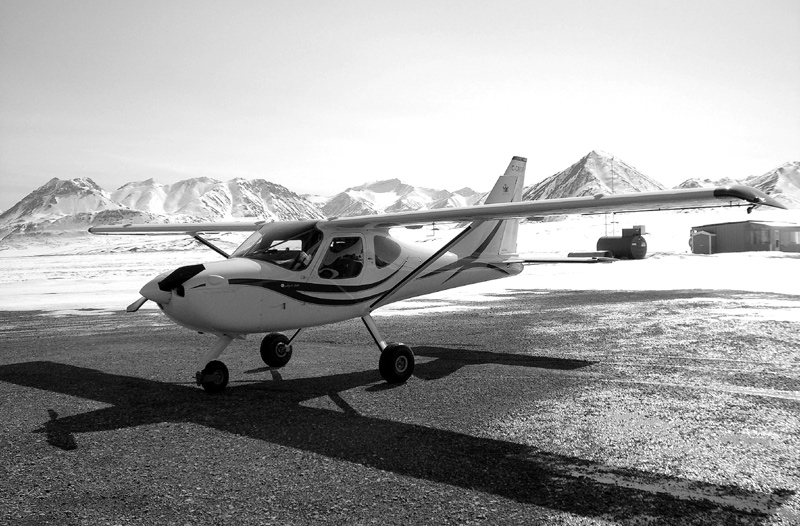 Our trip officially began on May 16th with a short hop to Abbotsford, BC to clear Canadian customs. This went fairly well considering their computer was down and that I had I shotgun with me. We were off in about an hour and on our way to Williams Lake to join up with Peter and Werner. After exchanging greetings and buying some avgas we were off to our next stop – Mackenzie, BC.
Our trip officially began on May 16th with a short hop to Abbotsford, BC to clear Canadian customs. This went fairly well considering their computer was down and that I had I shotgun with me. We were off in about an hour and on our way to Williams Lake to join up with Peter and Werner. After exchanging greetings and buying some avgas we were off to our next stop – Mackenzie, BC.
With all due respect to the town of Mackenzie, it isn’t much of a place. It is primarily a logging and lumber town with the last avgas for over 300 miles heading north. They also have a decent grocery store where we could get what we needed for dinner that night. Oh, yes. I forgot to mention its major tourist attraction: a huge forest crushing machine that didn’t work out. It was a big loser in the nature vs. technology battle, but it is kind of fun to see while you are in town. Mackenzie also roughly marks the beginning of Williston Lake, a long body of water that we would be following northeast for the next 100 miles or so.
Mackenzie took an unexpected shot at us just as we were leaving. Richard’s engine instrument display just decided to go on vacation, leaving him with nothing. Fortunately a few phone calls got him the information he needed to reboot the system, so only about an hour was lost. I am still skeptical about engine instruments that need to or even can be rebooted, but such are modern times.
The goal for the first night was Terminus Mountain, a hunting lodge and air strip that is in the well-known Trench about 100 miles south of the Yukon/British Columbia border. As we approached we were treated to many elk and moose sightings. Later from the deck in front of the lodge we saw mountain goats and Stone sheep. This is really an outdoorsman’s paradise. We were on our own for dinner, so we each dined according to how well we had considered our purchase of groceries in Mackenzie, with some fairing better than others.
The following morning we were off to Watson Lake and parts further north. Our flight plan, which interestingly included our overnight stop, called for us to be there by noon, so we weren’t under too much pressure. On the other hand we did have some ground to cover. Amazingly the lady selling us fuel at Watson Lake remembered me from two years ago. It was flattering to have made such an impression, but the truth is not much happens in Watson Lake.
Northway, AK was a little too far to make non-stop, so we set down in Whitehorse for fuel and something to eat. It is also a pretty quiet place with only about 23,000 people, but it does have air carrier service and serves as the capital of the Yukon Territory. This is as close as it gets to the “big city” in this part of the world.
After an unscheduled weather delay in Haines Junction we made our way into Northway, Alaska for US Customs. This is another real garden spot. Everyone there was real nice, but somehow they didn’t have a particular stamp that Werner needed in his passport. An agent had to drive the stamp out to the airport from a highway border crossing that was over an hour away. It was a good thing that the sun set late that far north. We finally got going again and pulled into Fairbanks around 9 PM. That was a long day.
The new goal was Deadhorse, the nearest airport to Prudhoe Bay. It wasn’t looking to good weather-wise, but we figured we would go as far as we could and see what happened. Everywhere else was clear, so nothing was at risk. Bettles was our last fuel stop heading north, so we topped off there. Then we made out way to Coldfoot where we picked up the Dalton Highway and the Alaska Pipeline. From the air the pipeline seems smaller that it ought to be somehow, but it was easy enough to follow as it made its way towards the Brooks Range.
Atigun Pass is the gateway to the North Slope and a whole different world. We were blessed with a crystal clear and calm day for our flight. Breathtaking just barely described the beauty of the mountains as we slid through the Brooks into a snow-covered world on the other side. It was as if we had stepped through the wardrobe into Narnia. Suddenly everything looked different. Galbraith Lake, on our former trip a mirror reflecting majestic mountains beyond, was now frozen and white. The strip there had patches of asphalt showing through here and there but was still mostly white with snow. We cautiously landed, fearing an icy reception, but had no problems. Now was the time to decide what to do. Peter, Werner, and Richard elected not to go any further in light of the poor forecast at Deadhorse. They turned around and flew back to Bettles for the evening. Jeff, Frank, Tom, and I, ever hopeful, decided to head north and take a look. Sixty miles south of Deadhorse we were greeted by a wall of fog that went from around 1,000 feet agl to the ground. I guess the forecast was right. All was not wasted, though, because we did spot some caribou along the way.
We dropped into Wiseman and Coldfoot on the way back. Wiseman is a little town along the pipeline route that dates back over 100 years. Many log cabins are still in use that go back almost that far and look it. Coldfoot gave us a chance to actually get out and touch the pipeline. Tom and I had seen it before, but Jeff and Frank got their first chance to really see where all that oil comes from. Coldfoot makes the claim of having the largest spread of recorded temperatures of anywhere on earth. They might be right. Their lowest recorded temperature was -82 degrees F and their highest was +97 degrees, for a spread of 179 degrees. Wow! We finally made it back to Bettles after dinner, only to find out what we had paid for in Coldfoot was included in the cost of our room. Oh, well.
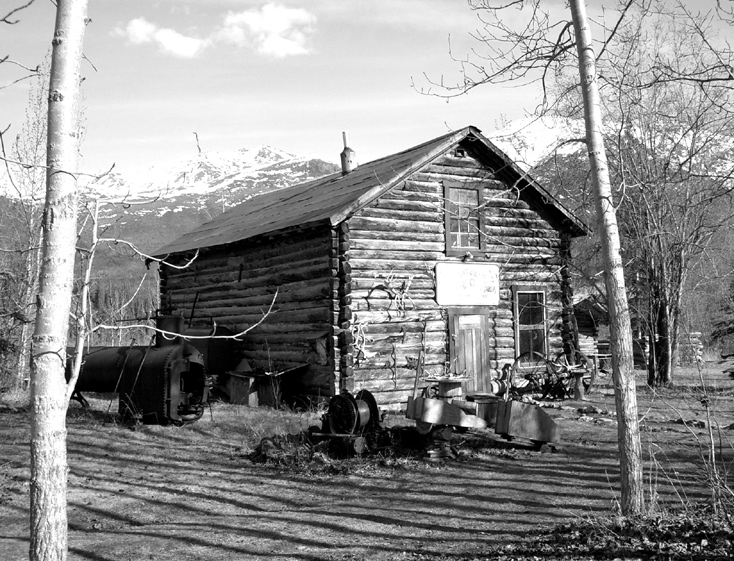
The next morning we pointed our noses southwest towards Galena. The Koyukuk River marked our course for much of the way and gave us something more interesting to guide us than our GPSs. My biggest problem was convincing everyone else that they weren’t going to see anything flying at 3-4,000 feet. I eventually got at least some of them to drop down to treetop level where they could see the moose and beaver along the river. To me this is the best part of Alaska flying. If you are going to stay high you might as well be flying over Nebraska.
GlaStar builders Buck and Gloria Buchanan call Galena their home now, and they rolled out the red carpet for us. The airport there is huge – a former Air Force base. In fact I think it is bigger than the town (well, almost). With Galena being an every-other-year waypoint on the Iditarod dog sled race, it was only fitting that we tour a local race kennel and pet the dogs. Tom and Werner especially seemed to take to the lively canines. Buck and Gloria couldn’t have been more gracious hosts. We departed there well fed and glad for the time we had spent there.
From Galena we followed the Yukon River east towards the pipeline again with the hope of finding Mt. McKinley clear and free of turbulence. Our first stop was at the McKinley Park airstrip where we had hoped to talk to the rangers about our proposed flight around the mountain. There was a nice little airport at the visitor center and lots of pretty buildings full of tourists, but the rangers were no help at all. I could have gotten as much useful information talking to my dog. Fortunately Richard knew someone who knew someone at one of the charter operators out of nearby Healy River. A quick hop over there provided us with maps, route suggestions, and other helpful hints that saved the day for us.
Armed with all the information we could digest, we began the climb out of Healy River towards “The Mountain.” As we made our way up to 10,000 feet (about half the height of McKinley) it became clear that staying close together and getting all the reporting points right was going to be a challenge. What looked so clear on the map looked more like a giant jumble of monstrous mountains when we got there. In spite of our confusion we managed to get a great view of McKinley and the surrounding peaks and glaciers. If the Atigun Pass was breathtaking, this was that times three. Words fail to describe adequately the rugged beauty of the place.
Songlo Vista was our end-of-the-day stop. It was not a public airport, so it wasn’t in any data base. We just had to find it the old fashioned way. It wasn’t too hard to pick it out once we found the Princess Lodge, but I think some of our group were expecting something that looked more like an airport. I saw Ursel Scoles’ Cessna 150 parked next to a rough strip cut out of the forest, and I saw the lodge, so I knew it had to be the place. We made a standard pattern with final between the trees and landed on a rough but adequate dirt strip with a noticeable uphill grade. After the fourth plane safely landed I called Ursel on the cell phone, and he was there before we knew it to take us to our rooms. Ursel is the maintenance manager of the Princess Wilderness Lodge, so he was able to get us a real deal on our rooms ($99 for a $250 room), plus, as an unexpected bonus, he wouldn’t let us pay for any food. Was that ever nice! Needless to say everyone in the group is now anxious to come back and visit Ursel. He really treated us well.
The only negative of our visit to the Songlo Vista strip was that Peter really beat up his prop getting in and out of there. Peter had worked on his plane to get more ground clearance for the trip, but the 10 inches of prop-to-ground clearance he ended up with and the fragility of his composite prop were just not up to the task. He was able to fill in the nicks and gouges when we got back to pavement, but that prop will never be the same. The 13.5 inches of clearance I was able to get and my tougher Hartzell prop stood up well, and the tail draggers didn’t have much trouble, as would be expected.
Before we left the next morning we were anxious to get Ursel some Sportsman time (since he is building one himself) and to see the mountains again. Peter was feeling a bit tired so he and Werner just relaxed for the morning, but the rest of us took off for another scenic flight. The mountains were again beautiful and the air was smooth, making our morning jaunt a great success. Ursel had hoped to take us into a gold mine strip at the base of the mountains, but a recent storm had washed out much of the runway. No problem. That will give us something to do next time.
We bid farewell to Ursel and our one-day life of luxury and headed south. After some gas in Talkeetna we dialed Homer into our GPSs. Boyd Walker and Vince Tillion were there waiting to host us and show off their planes. Vince has been flying his Soob-powered Sportsman for awhile now and really enjoys it. Boyd is still working on his NSI-Soob GlaStar, which would surely be flying by now if not for the problems he has had sorting out Lance Wheeler’s handiwork. They were both gracious hosts and enthusiastic about their planes. It was great fun meeting them.
As an added bonus we were treated to the sight of many bald eagles while in Homer. It was nice to see so many of the majestic birds. Their comeback has been a real success story as they are now being removed from the endangered species list. None of us seemed to grow tired of watching them.
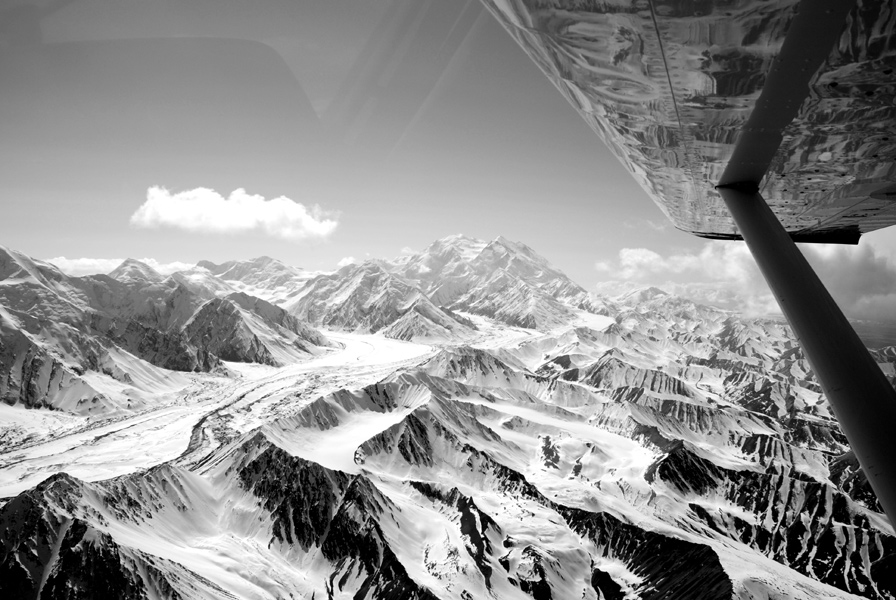
Our plan had been to fly along the southern coast from Homer to Skagway, but the weather was not cooperating. We might have made it, but it would have meant flying below a 1,000 foot overcast for a good 200 miles. As things turned out that wouldn’t have been a very good idea. I hated missing out on Skagway, though. Maybe next time.
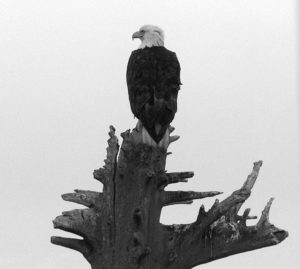
As we flew north out of Homer on our way to Whitehorse via the inland route, we hit some turbulence. A particularly sharp jolt knocked out my VM-1000 engine instrument display. There was then just a faint smell of electrical smoke, so I pulled the breaker and plotted a course to Anchorage to see if we could make the needed repairs. The group concurred that Anchorage would be the best bet for this important but non-emergency stop so we adjusted course. Not wanting to mix it up with the big boys I dialed in the Lake Hood strip, which adjoins Anchorage International, but is actually not in the Class C airspace. Lake Hood is a bush plane paradise, so the taxi to parking was a real treat. As an added bonus the taxiway crossed a road that got closed with railroad style crossing gates as we taxied across it. I had seen this before, but the other guys got a real kick out of it. We just motored through like we were the Union Pacific Railroad as cars were stopped by the gates.
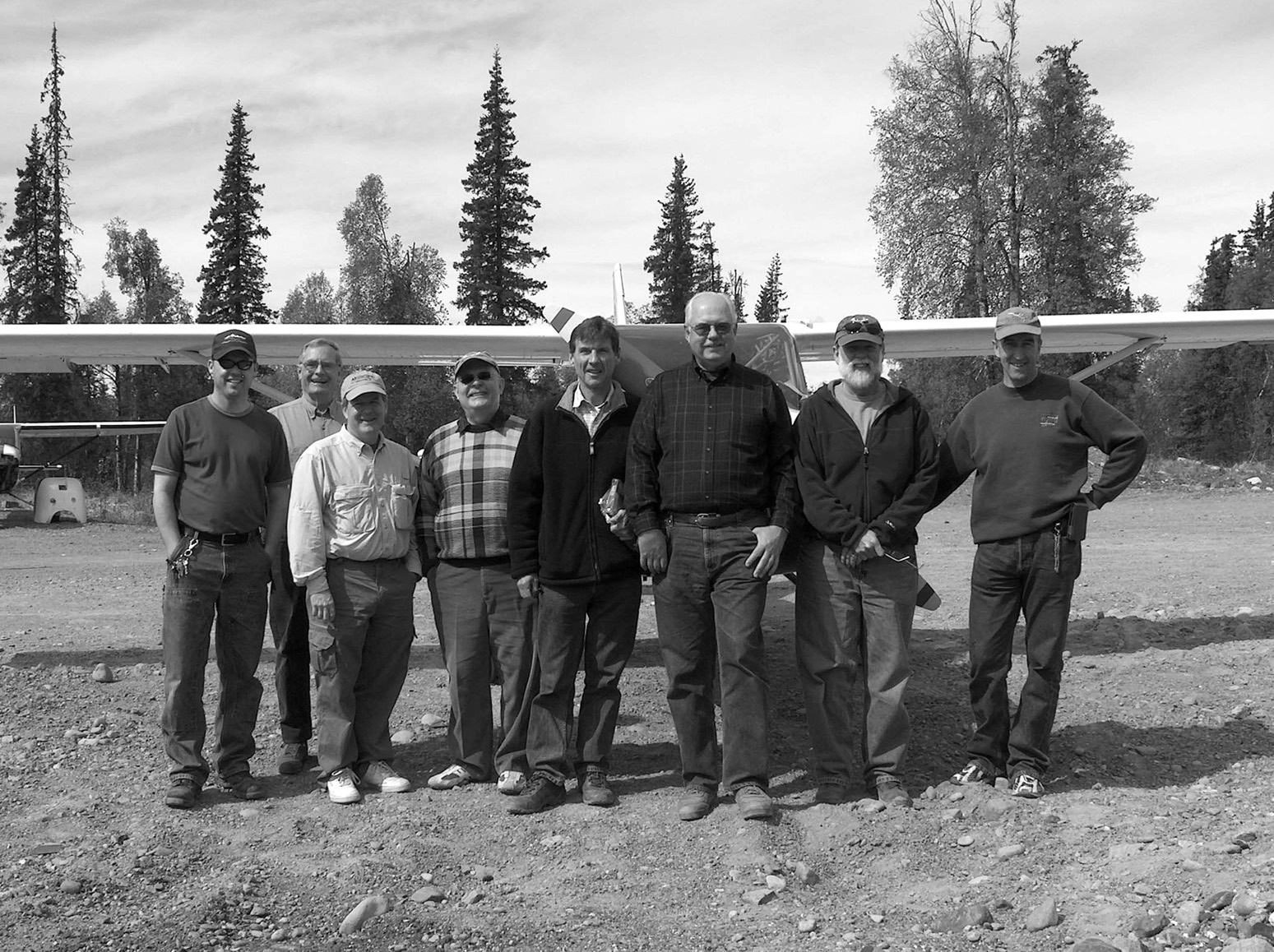
Luckily Werner and Tom were able to sort out the VM-1000 malady fairly quickly, keeping our delay to a reasonable hour or so. While they were diligently working another member, Paul Kvernplassen, dropped by to say hello. It is regrettable that we were not able to see more of our members in the Anchorage area, but somehow we just ran out of time. My apologies to those we missed.
The rest of the trip to Whitehorse was uneventful except for the roaring headwind we had to buck for the last 100 miles or so. It was easily the worst stretch of the whole trip, with 20 to 30 knots coming right at us. But even as we were growing weary of turbulence and slow progress through the air our spirits were buoyed by the sound of Whitehorse tower as we heard of a GlaStar inbound from the southeast (not one of us). Little did we know that Jeff Tyler was on his way back to Fairbanks, where he is an FSS briefer, after purchasing a GlaStar in Idaho. After landing and making the obligatory call to Canadian Customs we descended on Jeff en masse like he was a long lost friend. We quickly made him part of our group and headed into town for dinner and the night. The local cab company sent us their limo on account of the size of our group. Now that was unexpected to say the least. We had a great time eating pizza, drinking beer and talking to Jeff that night. You just never know where you are going to make a new friend.
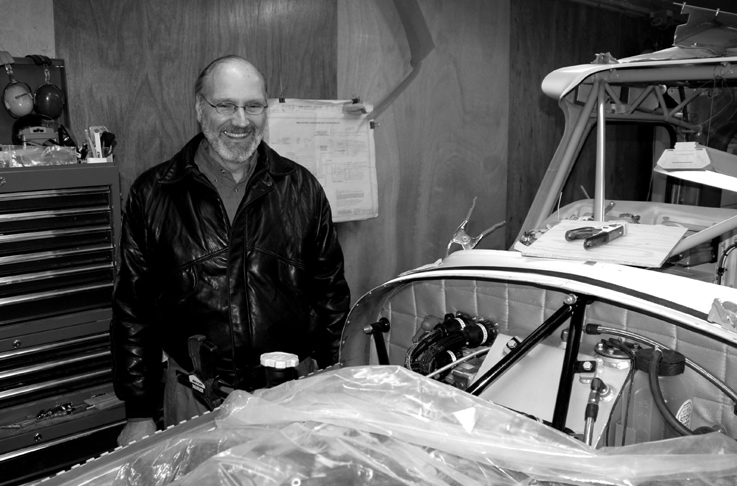
The next morning dawned innocently enough, but it was not to be Peter’s day. As we taxied out to take off his fuel vent line pulled lose and poured avgas all over him. We quickly retreated to help him sort out the problem. No sooner had that been resolved than he tried to start his engine only to be greeted by the sound of grinding gears. Apparently his engine had kicked back in an earlier start attempt and he had broken the casting of his Sky-tec starter. This inherent weakness is designed into the lightweight started to protect the engine, but it had grounded Peter until a new part could be secured. A quick call to Aerosport Power had a new starter on the way, but Peter and Werner were not leaving Whitehorse today. With Peter within a day’s flight of his home, the rest of us reluctantly decided to push on without him and Werner. I was not really comfortable with this arrangement, but it all worked in the end. There was certainly nothing any of us could have done to help Peter at this point.
The three planes remaining were off to Watson Lake for fuel and then Mackenzie or further if we could. We spent no time admiring the scenery of the Trench this time. It was straight to 8,500 feet and full power. As we approached Mackenzie our fuel situation looked good, so we pressed on to Prince George. A quick night’s stay and we were off again for Bellingham, WA, and back into the USA. We did have some fun talking to some aerial firefighters heading north from Prince George. We were surely glad we didn’t have to pay their fuel bill.
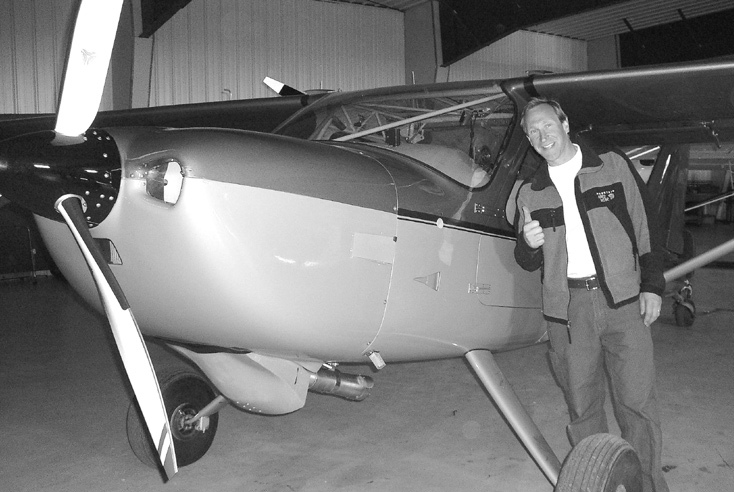
We were through US Customs by 1:00 in the afternoon. Jeff and Frank decided to lunch there in Bellingham and then try to go non-stop all the way to Palo Alto. Richard needed to go to Arlington and try to get his instrument panel straightened out. Tom and I decided to go to Arlington, too, just to have some lunch and say hi to everyone. From there we split up and headed south by ourselves. We made it to Ashland, OR that night and were home the following day, May 25th, with 61.5 hours of flying in the log book.
It is only normal that after such a trip we would look back and reflect upon what we just did. Did we have a good time? Yes, absolutely. Did we overdo it? Oh, yeah! Would we do things differently next time? Sure. Will there be a next time? I hope so.
Flying together lets you measure yourself and your plane against others. If you have never done this before it can be very instructive. I think everyone finished the trip a better pilot than when they left, and everyone learned things about their planes that could be improved. We also learned a thing or two about patience and getting along with each other. Interestingly many of the people on this trip had never even met each other before we left. In the cases of Peter and Werner and Jeff and Frank they had also not flown together before but yet managed to get along side by side in an airplane for 11 days. I found that almost amazing.
As for gear, if nothing goes wrong all that survival gear, spare parts, and tools look pretty ridiculous. But if something had gone wrong it would have been nice to have. It is always tough to decide how much is enough. We also had too much cold weather clothing, thanks to my recommendations. The interior of Alaska was definitely warmer than expected. But I guess it is safer to be too warm than too cold. Two things that were absolutely indispensable were the Canada Flight Supplement and the Alaska Chart Supplement. So much information is missing from the charts, especially the Canadian charts, that we would have really been lost without these two handy references. The one thing we needed more of was time. We just covered too much ground in too little time. A few more days to relax and see people would have made the trip much better.
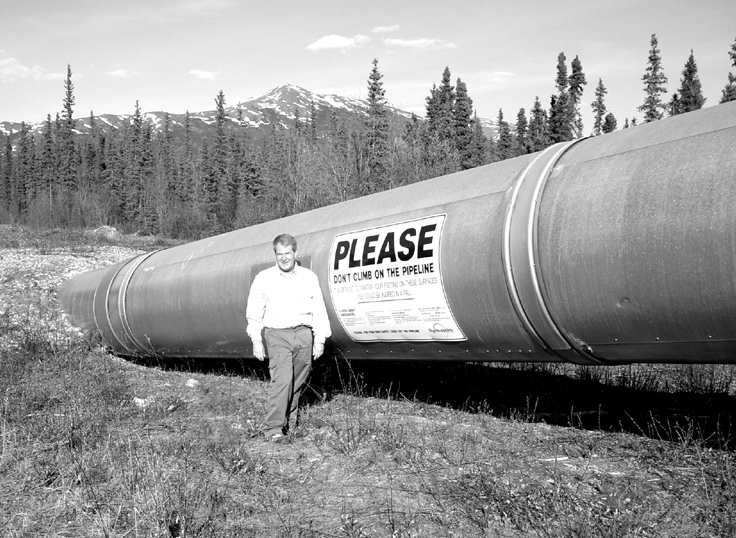
One last thing I learned was what really works plane-wise and what does not. Composite props on dirt strips do not work. I suspected that from my MT experience and Peter proved once and for all. And while on the subject of props, there is no substitute for clearance between the ground and your prop when landing on dirt. The thirteen inches plus that I had worked fine. Peter’s ten inches did not. On the roughest strips I think that tail draggers will always rule, but with the clearance I had my trike handled everything we came across with no problem. Both the GlaStars and the Sportsmen worked well, but the extra load carrying ability of the Sportsmen was most welcome. I didn’t have to leave anything out that I wanted to take. I thought I might really miss the extra power of the IO-390 I didn’t put in my Sportsman, but I really didn’t.
I hope to do this again some day. It is a big commitment to make a trip like this, but I think it is worth it. I hope at least a few more of you will join us next time for the adventure of your life.

